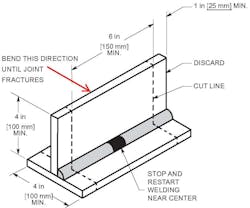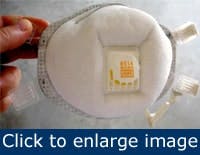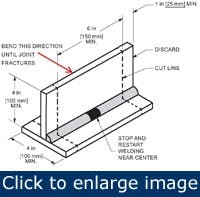Five key questions management should ask before repairing by welding
Components critical to plant operations often get repaired by welding, but occasionally those repairs don't work, or, even more exasperating, a part must be repaired repeatedly. There are key questions plant operations and maintenance supervisors should ask of those who will make the repair to determine whether they’ve researched what they’re about to do well enough to get it right the first time.
Question 1: Can it be welded successfully?
[pullquote]If the component was fabricated by welding, it’s a good indicator that it can be repaired by welding. However, it might be that special techniques, welding processes or electrodes were used in the original construction, or that the part was heat treated after welding to achieve the required properties. Supervisors should know what the material is before welding it. This can be done by examining construction drawings, consulting a maintenance handbook, contacting the manufacturer or looking for an ASTM, AISI, SAE or other material specification and grade markings that identifies the material on the part itself. Gather any other information that can be obtained about how the part was made. As a last resort, you might have to cut a small wedge from the part and have it analyzed in a laboratory.
Armed with this information, you can contact a reputable resource such as a welding consumables manufacturer (Lincoln, Hobart, ESAB, etc.) or a welding engineering consultant for guidance. Go beyond your regular welding supply salesmen unless you know they have a technically competent consulting staff. At a minimum, establish the following during this step:
- The appropriate welding process or processes to be used
- Welding electrodes or filler metals to be used
- Preheating and postweld heat treating requirements
- Any special requirements, such as cleaning, heat input control or peening, that are unique to the material that might improve its weldability
- When appropriate, a way to remove defects and a requirement to verify that they have been removed before starting to weld.
- In-process inspection points such as verification that the correct materials are being used, the tack welding and fit-up are correct, the root pass is good, and the welder properly cleaned and contoured the weld beads between passes
- Final inspections and nondestructive examination (e.g., X-ray or ultrasonic) where appropriate.
Question 2: Is it safe?
The second question is whether welding the material is safe. Once your staff has figured out how to weld the component, make sure the component is safe to weld on and that the environment is safe. Parts that might have contained combustible materials need to be thoroughly cleaned and vented; any connections that might supply combustible gas or liquid to the component during welding should be disconnected where possible, or a combustible gas meter used to monitor the vent exhaust gas. Take special precautions when dust can reach explosive concentrations. Obviously, if a welder has to enter a confined space to make a repair, the suitability of the air in that space should be verified and appropriate confined-space entry practices must be followed.
The welding environment should be free of combustible materials. Generally, any combustibles within 35 feet of where the welding is to be performed should be removed or covered with fire-resistant fabric to prevent ignition. This includes floors both above and below the work area where sparks might fly through gratings or manways or under partitions. Fire watches are always a good idea when welding in the plant environment.
Figure 1. An N-95 type welding fume particulate mask is effective against zinc oxide when torch-cutting or welding galvanized steel, but a fume mask is not a substitute for proper ventilation of the welding area.
Parts to be welded should be clean and free of paint, grease, oil, rust, moisture and other contaminants. Lead-containing paint was banned in 1977, so any paint that was applied before then should be sampled to see if it contains lead and, when it is removed in preparation for welding, appropriate precautions taken to avoid contaminating the workforce. Galvanized surfaces should be power-wire-brushed to remove heavy galvanizing; however, workers can protect themselves from the zinc oxide that is developed by torch-cutting or welding galvanized steel and other particulate by wearing an N95-type particulate filter mask such as that shown in Figure 1.
Consult ANSI Z49.1 Safety in Cutting, Welding and Allied Processes for further guidance on welding safety. It’s available for free download from the American Welding Society.
Remove external loads from components before welding by disassembly, depressurization or other means. Building steel presents a special situation since loads typically can’t be removed, so consult with a competent structural engineer before welding on it. Guidance on welding on existing building steel can be found in AWS D1.7, Guide for Strengthening and Repairing Existing Structures.
Question 3: Are there rules?
The third question is about any codes or jurisdictional rules that have to be followed. While a formal welding procedure isn’t required for a lot of repair work, formal welding procedures usually are required by the AWS D1.1, Structural Welding Code — Steel, when welding on buildings or structures, and by the ASME Boiler and Pressure Vessel Code, or the ASME B31 Code for Pressure Piping when welding on pressure parts such as piping, pumps, boilers or vessels. Of special concern are boilers, tanks and piping having a nameplate with “ASME” stamped on it. In most jurisdictions, only contractors that have an “R” Stamp issued by the National Board of Boiler and Pressure Vessel Inspectors can weld on these components. Where formal welding procedures aren’t required, obtain guidance from the welding electrode or filler metal manufacturer and put it into concise form for the welder to follow when making the repair.
When formal welding procedures are required, formal qualification of the welder also is required. For other repair work, a welder with a past history of successful welding in your facility with the welding process and filler metal type to be used for the repair is probably sufficiently skilled.
Figure 2. The welder makes a weld in the location shown. The portions designated as “discard” are saw-cut off, and the remaining portion is bent so that the root of the weld is put in tension. If the plate bends on itself, the weld is good; if the weld fractures, the fracture surface is examined for excessive defects (based on AWS B2.1:2000, Figure 3.8, reproduced with permission of the American Welding Society (AWS), Miami).
For a welder of unknown skill, or if the materials represent a new experience, the welder can demonstrate skill at minimal cost to you by fillet welding together two plates of a material similar to that to be repaired, to form a “T” as shown in Figure 2. This T can be bent and the resulting fracture evaluated. The test piece should be welded in whatever position the welder must work to make the repair.
Question 4: Preheating or heat treatment?
Next, ask whether preheating or postweld heat treatment is necessary. Recommended practices from the welding consumables suppliers should address preheating with regard to the base metal to be welded. For common structural steels like A-36, A-500 and the like, preheating the parts above ambient isn’t normally required, provided low-hydrogen processes like GTAW (i.e., TIG or Heliarc) or GMAW (i.e., MIG) or low-hydrogen electrodes such as E7018 or E8018 are used.
When welding these materials and the component thickness exceeds 3/4 inch, preheating steel to 200°F is good practice. Other materials such as 4130 and similar low-alloy steels used for shafts and gears commonly require preheating, and you should follow the recommendations of the welding consumable manufacturer. Some materials require postweld heat treatment to restore ductility and toughness, so competent technical assistance becomes more important as materials being welded become more sophisticated.
Question 5: What’s the root cause?
The next question concerns whether you’ve fixed this before. One of my favorite asides is: “Oh, we repair that every couple of months.” When something requires repair more than a few times, it’s time to call in the big guns and perform a failure analysis. This can be as simple as having a competent engineer look at what’s going on and identify the root cause, or as complex as examining fracture surfaces in a scanning electron microscope and performing other metallurgical examinations and tests.
Figure 3. The weld on a pipe in this high-pressure hydraulic piping system has been repaired several times. While adding weld metal might stop the leak temporarily, it’s not an effective or long-term repair.
Figure 3 shows a weld repair on a hydraulic piping system that provided 3,000-psi hydraulic fluid to a big shear in a scrap yard. While the repair weld was effective temporarily, it would crack again every few weeks, spraying (fortunately!) nonflammable, hydraulic fluid over the equipment. In a much more sophisticated facility with a similar problem, the owner had put a trench around the equipment to capture the fluid, resigned to the fact that it leaked and that’s simply the way it was.
In both cases, the rapid opening and closing of valves produced pressure waves in the pipe. In both cases, it was noted that the pipe shook when valves opened; the shake was absorbed where the pipe was attached to firmly anchored components, resulting in high bending stress at the welds closest to the components.
This stress led to cracking and leaking at the welds. While part of the solution was to replace the piping and examine all the welds radiographically to ensure that the welds were of top quality, the piping also was anchored directly to the equipment or the foundation using rigid pipe supports, so the supports rather than the piping welds absorbed the shake. The equipment warmed considerably when in use, so locating the anchors properly was important because anchors limit thermal expansion and, if thermal growth is excessively restrained, high cyclic stresses arise at other locations in the piping system, which leads to failure at those locations instead of at the equipment connections.
Failures that are obviously mechanical in nature can, in many cases, be repaired by welding, following the above guidance. However, it’s important to be sure the defect is removed adequately before welding. The welds in Figure 3 were simply added to those already in place — an expeditious way to get the equipment back in service, perhaps, but welding over a crack always should be recognized as only a short-term fix.
Walter J. Sperko is president of Sperko Engineering in Greensboro, N.C. Contact him at [email protected] and (336) 674-0600.



